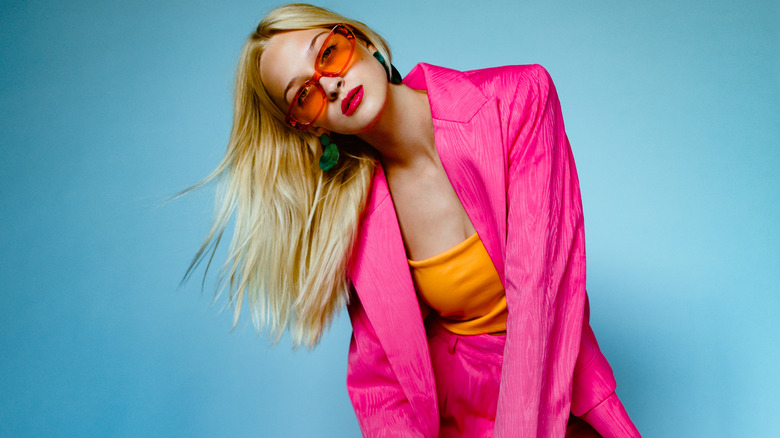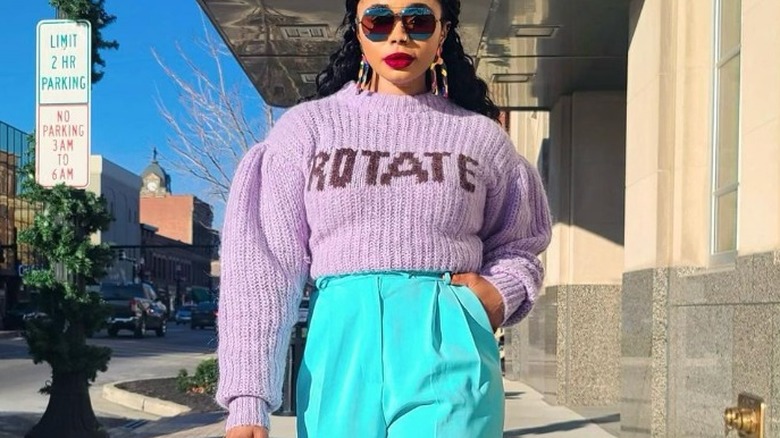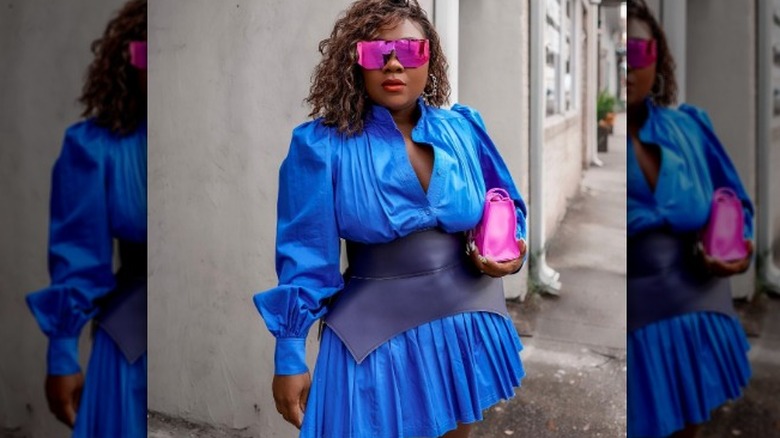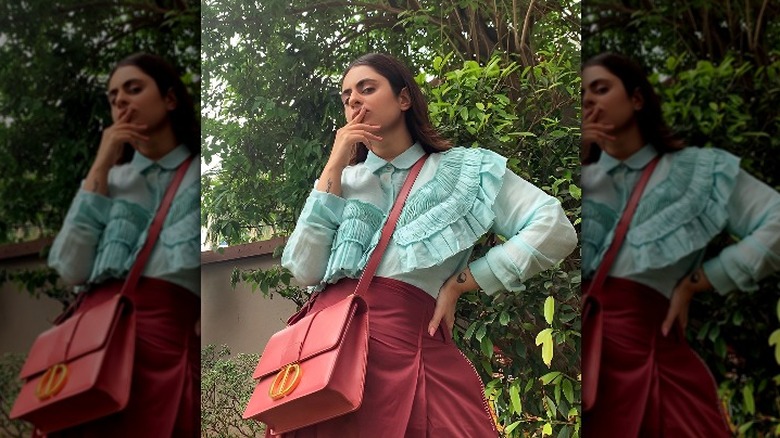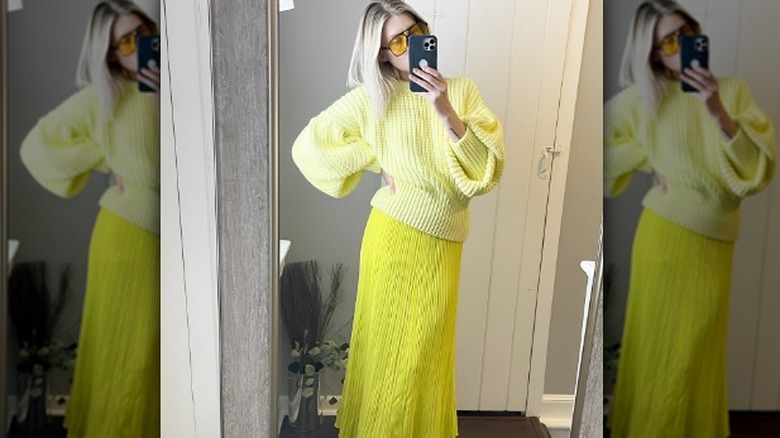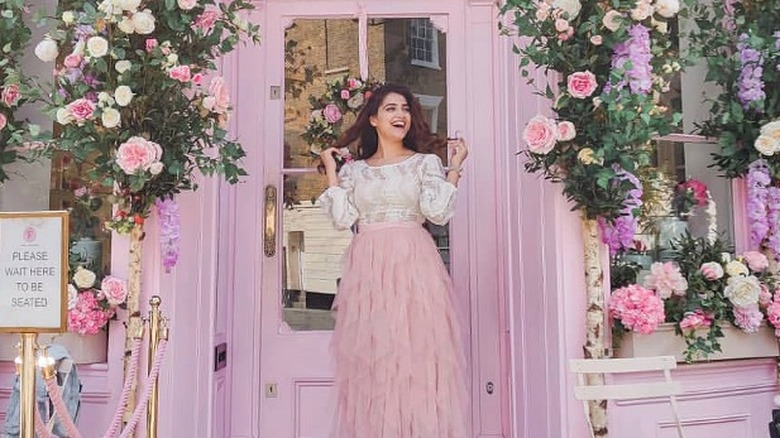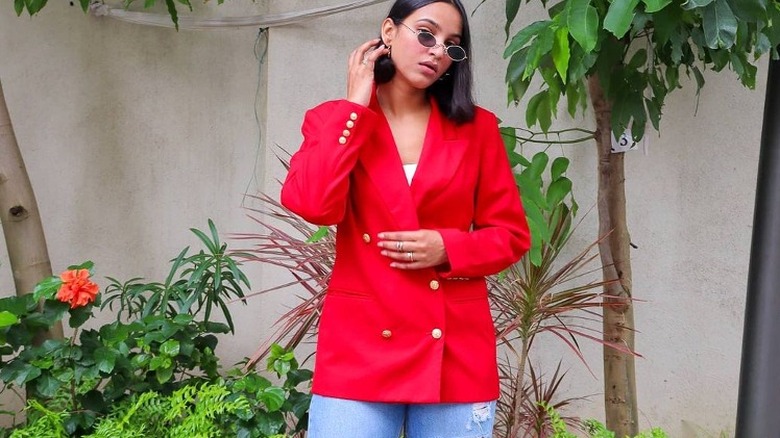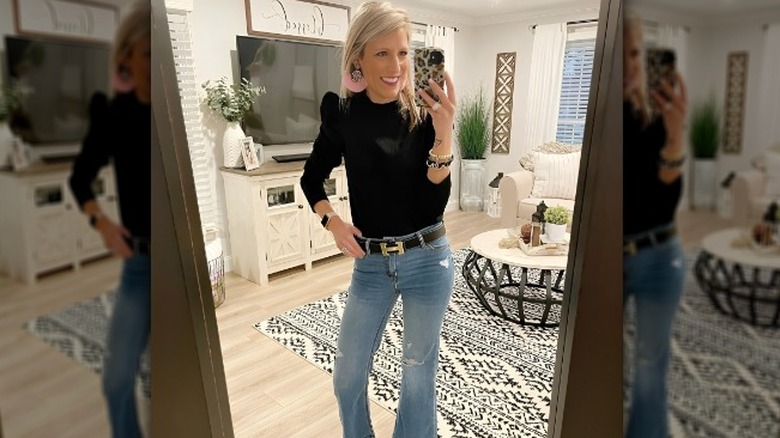Tips For Infusing More Color Into Your Wardrobe
In a world rife with fads and fetishes like fashion, neutrals such as black, white, and grays will always be timeless. Not only are they great for all occasions, but they also make you feel less anxious about experimenting with new styles and offer a major mixing-and-matching utility. While going neutral is timelessly safe, you might miss out on the many psychological perks of a deeply saturated wardrobe. "Research shows that colors can have a psychological effect," says the author of "How Not To Wear Black," Jules Standish (via Daily Mail). Being decked out in warm and bright shades such as red or pink releases dopamine, a "feel good" hormone that elevates our mood and attention span in addition to our sex drive, Standish explains.
This type of dopamine-centered dressing is also known as "dopamine dressing," a trend rooted in the thinking that you become happier when you dress to your taste. "Dopamine dressing is all about wearing what makes you feel good," style expert Whitney Keefe tells Byrdie. What makes you feel good can be a certain fit, texture, print, or color. If you — like Wednesday Adam — are hypersensitive to colors and nothing perks you up more than dark academia aesthetics, stick with neutrals. However, if you've always wanted to add a splash of color to your look but lack the confidence and the experience to do so, this article is written with you in mind. Below, check out tips for infusing more colors into your wardrobe.
Opt for colors that resonate with you
If you are unsure where to begin, start with the colors you are drawn to."Everyone has a color or two they like," Dr. Matt Johnson tells SELF. Different colors can evoke different feelings. For instance, warm and attention-grabbing hues like red, orange, and yellow and their variations can evoke feelings of energy and heightened alertness. Meanwhile, colors on the blue side of the spectrum, such as blue, purple, and green, can express indifference and sadness, per Verywell Mind. Pastel colors are your best bet if you want to exude a calming presence. Depending on the vibes you'd like to create, choose a color that most resonates with you.
Another factor to keep in mind when choosing a bright-colored outfit is your skin tone. According to personal stylist Trish Murray (via SHE DEFINED), the colors that brighten your features and make your complexion glow instead of washing it out — are the right ones. For instance, navy blue, olives, golden brown, and deep grays flatter those with a warm, golden skin undertone. Meanwhile, those with cool skin undertones look great in vibrant colors such as bright blues, deep violet, and pink.
Color-blocking is the key to harmonious contrast
When in doubt, look to the color wheel for color-blocking cues. Color-blocking is defined by College Fashion as a technique used to generate maximum contrast in an outfit by coordinating colors opposite each other on the color wheel. The blocks can be made by combining different colored pieces or by using patterns or seams within a garment. For instance, violet and yellow are exactly across each other on the color wheel, which makes them perfectly complementary and fitting to be worn together. Other "opposites-attract" pairs on the wheel are orange and blue, as well as red and green.
Another way to ride on the color wheel is to go analogous, which is to combine colors that sit next to each other on the wheel. Adjacent colors are close in shades and harmonious to the eyes when put together. For instance, red and violet are next to each other on the wheel, so they would look great together. And that's exactly the color combo that Meghan Markle (via Harper's Bazaar) rocked when making an appearance in Birkenhead, England. At the event, the actress was seen blocking a red wrap coat with matching heels and a purple dress for a strikingly sophisticated look.
Combine pastel colors
If you're a stickler for a muted, "less in the face" dressing style, go for subtle hues like pastel colors. Also known as tints, pastel colors are created by mixing white with the original shades so that the byproducts of the combination are the softer, low-chroma versions of primary and secondary colors, according to Creatopy.
Due to their low saturation, pastels are more soothing to the eyes while evoking a sense of freshness and refinement. Pastel colors are incredibly versatile since there is no specific color family to which they belong because they are made of various shades. It's safe to say that all of them work harmoniously together.
You can combine pastel hues based on the color-blocking principles, mix different shades, or even pair them with primary colors for a more striking look. Take a leaf out of @shereenlovebug's book and pair a ruffled shirt in a medium-light shade of green with a deep pink skirt with a matching flap bag. This pastel-yet-not-so-unsaturated look is feminine yet intriguing at the same time.
Go monochromatic
Going monochromatic is another approach to looking stylish and put-together in colorful clothes. Let's get the facts straight: monochrome fashion is not just about wearing one shade of color from head to toe — like the late Queen Elizabeth always did. You can also don different shades of the same color family for an on-pitch but varied look. "Think tone on tone, not matchy-matchy," says fashion blogger Natalie Yerger.
Aside from making you look smart and fashion-conscious, wearing shades close to each other displays an uninterrupted flow of color for the eye, giving the illusion of a taller and slimmer silhouette, Art In The Find points out. For instance, as a case in point, you can match your Ferrari jacket with a dress in a lighter shade of red or pink — like salmon, blush, or rose. Since a monochrome look has a lot going on, don't be afraid to experiment with contrasting fabrics for a dynamic look. For instance, flannel and leather play off one another beautifully, while the luxe smoothness of silk makes it the perfect match for casual corduroy.
Add a splash of white to any color
You can never go wrong with adding a neutral color to a vibrant hue for a balanced outfit. White — combined with any color, including itself — is a match made in heaven. When you're not sure if two vibrant colors clash with each other, ditch one for white. A shade of pure white helps calm down and even adds an exquisite touch to a bright-colored outfit that might come across as too overpowering for the eyes.
For recommendations on how to pair white with pink, check out this sweet and straightforward ensemble from @dikshavohra. Pulling a stylish number in a layered skirt in pastel pink, she makes her ladylike skirt pop even more by donning a boat-neck white blouse, evoking a feeling of joy and cheerfulness. The all-pink background creates a perfect canvas for the look.
Another neutral that works beautifully with just any color is black. "While black is traditionally a high-contrast color, it can be placed with just about any color to create different looks," says designer Betsy Wentz (via Apartment Therapy). You can block black with its opposite color, red, or pair it with a sweet hue like pink to balance out its excessive dressy energy. A little black will bring depth and drama to any festive colors.
Choose a classic cut
One of the easiest and most effective ways to incorporate colors into your wardrobes is to opt for timeless pieces, The Kit advises. Simple cuts and elegant overall aesthetics, in addition to a fine choice of fabrics, give classic clothing items tremendous versatility. Such articles of clothing will always draw attention — in a good way — when worn in a vivid color with striking designs.
According to Fibre2Fashion, some ageless staples that look good in all colors include tweed jackets, trench coats, single-breasted blazers, pencil skirts, pinstripe shirts, white button-downs, and cashmere pullovers. T-shirts, wide-leg pants, jeans, and sheath dresses are also essential and interchangeable pieces that amplify the number of styles created. If most of your timeless pieces are in neutrals, you can still add a pop of color to your ensemble by incorporating colored accessories such as pumps, leggings, scarves, hats, and clutches.
Another reason why it's wise to invest in a foundational wardrobe of classic silhouettes is because it makes you look luxe for less. Classic style pieces are usually made from high-quality materials and free of over-the-top or trend-focused details, giving you a polished, high-fashion appearance while lasting longer than your other fast-fashion pieces.
Go big with colorful accessories
If you're wearing a neutral-colored outfit that's slightly underwhelming, you can add a touch of glam to your look by going bold with your accessories, per Dressbarn. Play around with vibrant, trendy accessories, such as a pair of pink sunglasses, studded shoes, or neon earrings. According to Kandere, one piece of colorful jewelry — like one chunky necklace, a sparkling multi-row bracelet, or a pair of statement earrings— is enough to make your outfit stand out.
If you're wearing multiple accessories, consider combining colorful jewelry with another accessory of a darker or lighter shade from the same color family for a balanced, softer look. It's also worth pointing out that over-accessorizing can ruin your outfit, whether you're wearing neutrals or colors. Balance is the key, so try not to cover your body with oversized, colorful accessories that take the attention away from your outfit. The general rule is to include no more than two accessories in one ensemble, especially when color-blocking multiple bright colors.
